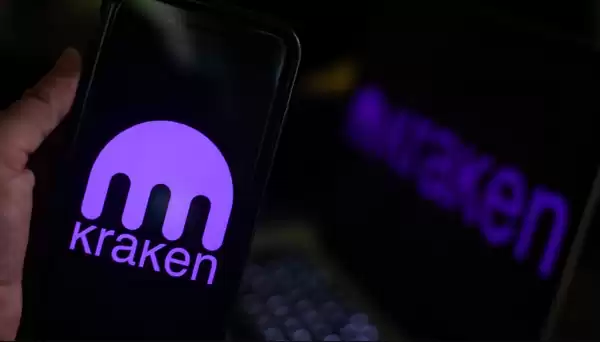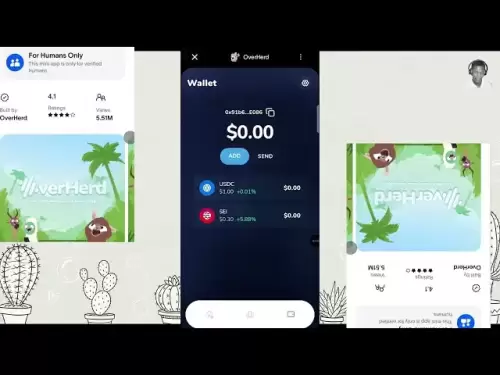-
 Bitcoin
Bitcoin $113800
-0.91% -
 Ethereum
Ethereum $3582
-3.04% -
 XRP
XRP $2.939
-4.32% -
 Tether USDt
Tether USDt $0.9999
0.00% -
 BNB
BNB $749.8
-2.02% -
 Solana
Solana $162.6
-3.81% -
 USDC
USDC $0.9998
-0.01% -
 TRON
TRON $0.3324
-0.44% -
 Dogecoin
Dogecoin $0.1977
-5.50% -
 Cardano
Cardano $0.7180
-4.86% -
 Hyperliquid
Hyperliquid $37.47
-3.76% -
 Stellar
Stellar $0.3910
-5.69% -
 Sui
Sui $3.384
-5.06% -
 Bitcoin Cash
Bitcoin Cash $551.7
-3.97% -
 Chainlink
Chainlink $16.19
-4.80% -
 Hedera
Hedera $0.2357
-5.31% -
 Ethena USDe
Ethena USDe $1.001
0.01% -
 Avalanche
Avalanche $21.74
-5.26% -
 Litecoin
Litecoin $118.4
-2.44% -
 UNUS SED LEO
UNUS SED LEO $9.004
0.60% -
 Toncoin
Toncoin $3.159
-6.97% -
 Shiba Inu
Shiba Inu $0.00001198
-4.16% -
 Uniswap
Uniswap $9.450
-4.55% -
 Polkadot
Polkadot $3.595
-2.90% -
 Dai
Dai $0.0000
0.01% -
 Monero
Monero $289.0
-4.92% -
 Bitget Token
Bitget Token $4.277
-2.69% -
 Cronos
Cronos $0.1375
-2.03% -
 Pepe
Pepe $0.00001008
-5.73% -
 Aave
Aave $252.9
-4.71%
How to play Kraken delivery contracts
Kraken delivery contracts offer a cash-settled way to speculate on cryptocurrency prices, with leveraged exposure using futures contracts that expire at specific dates.
Nov 10, 2024 at 06:36 pm

How to Play Kraken Delivery Contracts: A Comprehensive Guide
Introduction
Kraken, a leading cryptocurrency exchange, offers delivery contracts that allow traders to speculate on the future price of cryptocurrencies without taking ownership of the underlying asset. These contracts provide leveraged exposure to the market, enabling traders to amplify their profits or losses. This guide will provide a comprehensive overview of how to play Kraken delivery contracts, encompassing key concepts, trading strategies, and risk management techniques.
Understanding Delivery Contracts
1. Definition and Key Features:
- Kraken delivery contracts are futures contracts that obligate the buyer to purchase or the seller to deliver a specific amount of cryptocurrency at a predetermined price and date.
- They are cash-settled contracts, meaning that traders settle their positions in cash rather than taking or delivering the underlying asset.
- Contracts have varying durations, such as quarterly or perpetual, and are traded with leverage, allowing traders to control a larger position with a smaller amount of capital.
2. Key Metrics:
- Contract Size: The amount of cryptocurrency underlying each contract, e.g., 1 BTC per BTCUSD contract.
- Trade Date: The date when the contract is traded.
- Expiry Date: The date when the contract expires and is settled.
- Mark Price: An estimate of the fair market value of the underlying asset, used for margin calculations.
- Index Price: A reference price calculated using a weighted average of prices from multiple exchanges.
Trading Delivery Contracts
3. Account Setup and Funding:
- Create a Kraken account and complete the verification process.
- Fund your account with the necessary amount of cryptocurrency or fiat currency.
- Select the "Futures" tab on Kraken's trading platform.
4. Selecting a Contract:
- Choose the cryptocurrency and contract duration that align with your trading strategy.
- Consider the contract's size, liquidity, and expiration date before entering a position.
5. Placing an Order:
- Select the "Order Entry" tab and choose the order type: Market, Limit, Stop-Loss, or Take-Profit.
- Enter the desired contract quantity and price.
- Review the order details and confirm the execution.
6. Managing Your Position:
- Monitor your open positions regularly, adjusting or closing them as needed.
- Adjust stop-loss or take-profit orders to manage risk and lock in profits.
- Margin Requirements: Maintain sufficient margin in your account to cover potential losses. The initial margin requirement varies depending on the contract and market conditions.
Trading Strategies
7. Technical Analysis:
- Use technical indicators, chart patterns, and trend analysis to identify potential trading opportunities.
- Study support and resistance levels, moving averages, and momentum indicators to gain insights into price action.
8. Scalping:
- Execute a series of small trades in rapid succession, aiming for quick profits from small price movements.
- Keep positions open for short periods, managing risk closely.
9. Trend Trading:
- Identify long-term market trends and trade in the direction of the trend.
- Hold positions longer than scalpers, aiming for substantial gains from large price swings.
Risk Management
10. Setting Stop-Loss Orders:
- Place stop-loss orders to limit potential losses in case of adverse price movements.
- Monitor the market and adjust stop-losses accordingly.
11. Position Sizing:
- Determine the appropriate position size based on your risk tolerance and account balance.
- Avoid overleveraging, as it can result in significant losses.
12. Margin Maintenance:
- Maintain sufficient margin to cover potential losses and avoid liquidation.
- Close losing positions or add additional margin if the market moves against you.
Disclaimer:info@kdj.com
The information provided is not trading advice. kdj.com does not assume any responsibility for any investments made based on the information provided in this article. Cryptocurrencies are highly volatile and it is highly recommended that you invest with caution after thorough research!
If you believe that the content used on this website infringes your copyright, please contact us immediately (info@kdj.com) and we will delete it promptly.
- XRP, DOGE, and the Altcoin Darling Dilemma: Where's the Alpha?
- 2025-08-06 08:30:11
- Beatrix Potter 50p Coins on eBay: A Collector's Guide to Value and Rarity
- 2025-08-06 08:50:12
- Dogecoin Price Outlook 2025: Barking Up the Right Tree?
- 2025-08-06 08:35:17
- Floki Price Super Cycle Watch: Key Support Holds, Will the Viking Dog Fly?
- 2025-08-06 08:50:12
- Executive Order vs. Financial Institutions: Is Political Bias the New Normal?
- 2025-08-06 08:55:11
- Solana, Jito, and Protocol Fees: A new era for jito dao
- 2025-08-06 09:10:12
Related knowledge

Why is my Bitstamp futures position being liquidated?
Jul 23,2025 at 11:08am
Understanding Futures Liquidation on BitstampFutures trading on Bitstamp involves borrowing funds to open leveraged positions, which amplifies both po...

How to report Bitstamp futures for taxes?
Jul 30,2025 at 08:35am
Understanding Bitstamp Futures and Taxable EventsWhen trading Bitstamp futures, it’s essential to recognize that these financial instruments are treat...

Does Bitstamp offer inverse contracts?
Jul 23,2025 at 01:28pm
Understanding Inverse Contracts in Cryptocurrency TradingIn the realm of cryptocurrency derivatives, inverse contracts are a specific type of futures ...

What is the difference between futures and perpetuals on Bitstamp?
Jul 27,2025 at 05:08am
Understanding Futures Contracts on BitstampFutures contracts on Bitstamp are financial derivatives that allow traders to speculate on the future price...

How to find your Bitstamp futures trade history?
Jul 23,2025 at 08:07am
Understanding Bitstamp and Futures Trading AvailabilityAs of the current state of Bitstamp’s service offerings, it is critical to clarify that Bitstam...

Can I use a trailing stop on Bitstamp futures?
Jul 23,2025 at 01:42pm
Understanding Trailing Stops in Cryptocurrency TradingA trailing stop is a dynamic type of stop-loss order that adjusts automatically as the price of ...

Why is my Bitstamp futures position being liquidated?
Jul 23,2025 at 11:08am
Understanding Futures Liquidation on BitstampFutures trading on Bitstamp involves borrowing funds to open leveraged positions, which amplifies both po...

How to report Bitstamp futures for taxes?
Jul 30,2025 at 08:35am
Understanding Bitstamp Futures and Taxable EventsWhen trading Bitstamp futures, it’s essential to recognize that these financial instruments are treat...

Does Bitstamp offer inverse contracts?
Jul 23,2025 at 01:28pm
Understanding Inverse Contracts in Cryptocurrency TradingIn the realm of cryptocurrency derivatives, inverse contracts are a specific type of futures ...

What is the difference between futures and perpetuals on Bitstamp?
Jul 27,2025 at 05:08am
Understanding Futures Contracts on BitstampFutures contracts on Bitstamp are financial derivatives that allow traders to speculate on the future price...

How to find your Bitstamp futures trade history?
Jul 23,2025 at 08:07am
Understanding Bitstamp and Futures Trading AvailabilityAs of the current state of Bitstamp’s service offerings, it is critical to clarify that Bitstam...

Can I use a trailing stop on Bitstamp futures?
Jul 23,2025 at 01:42pm
Understanding Trailing Stops in Cryptocurrency TradingA trailing stop is a dynamic type of stop-loss order that adjusts automatically as the price of ...
See all articles

























































































